technical specifications FIAT QUBO 2010 1.G Workshop Manual
[x] Cancel search | Manufacturer: FIAT, Model Year: 2010, Model line: QUBO, Model: FIAT QUBO 2010 1.GPages: 230, PDF Size: 4.38 MB
Page 54 of 230
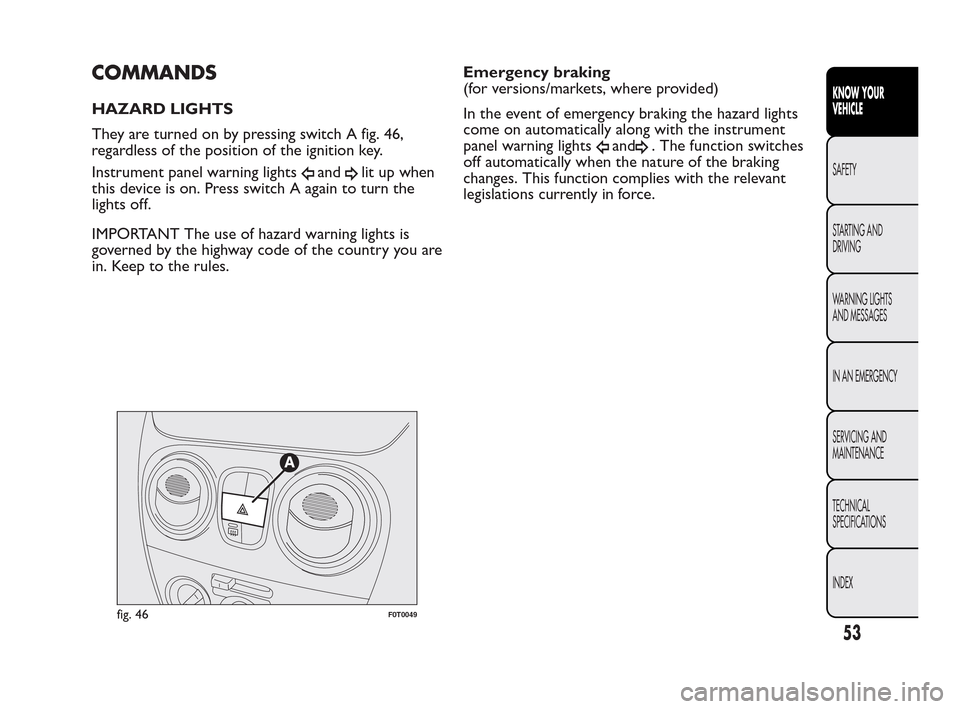
COMMANDS
HAZARD LIGHTS
They are turned on by pressing switch A fig. 46,
regardless of the position of the ignition key.
Instrument panel warning lights
andlit up when
this device is on. Press switch A again to turn the
lights off.
IMPORTANT The use of hazard warning lights is
governed by the highway code of the country you are
in. Keep to the rules.Emergency braking
(for versions/markets, where provided)
In the event of emergency braking the hazard lights
come on automatically along with the instrument
panel warning lights
and. The function switches
off automatically when the nature of the braking
changes. This function complies with the relevant
legislations currently in force.
fig. 46F0T0049
53
KNOW YOUR
VEHICLE
SAFETY
ST
ARTING AND
DRIVING
WARNING LIGHTS
AND MESSAGES
IN AN EMERGENCY
SERVICING AND
MAINTENANCE
TECHNICAL
SPECIFICATIONS
INDEX
Page 55 of 230
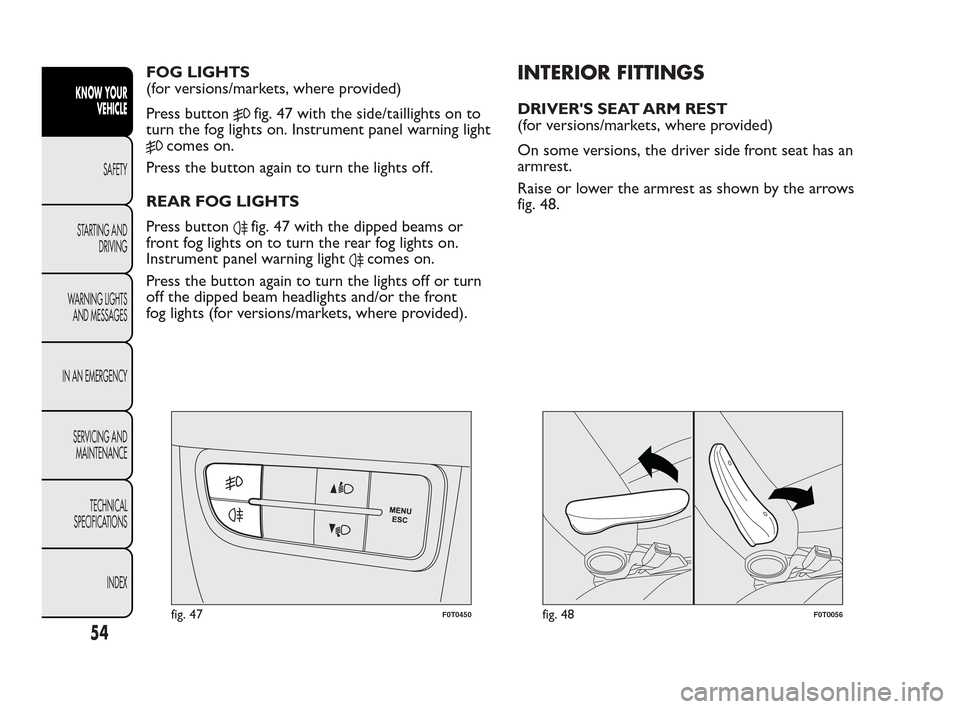
FOG LIGHTS
(for versions/markets, where provided)
Press button
fig. 47 with the side/taillights on to
turn the fog lights on. Instrument panel warning light
comes on.
Press the button again to turn the lights off.
REAR FOG LIGHTS
Press button
fig. 47 with the dipped beams or
front fog lights on to turn the rear fog lights on.
Instrument panel warning light
comes on.
Press the button again to turn the lights off or turn
off the dipped beam headlights and/or the front
fog lights (for versions/markets, where provided).
INTERIOR FITTINGS
DRIVER'S SEAT ARM REST
(for versions/markets, where provided)
On some versions, the driver side front seat has an
armrest.
Raise or lower the armrest as shown by the arrows
fig. 48.
fig. 47F0T0450fig. 48F0T0056
54
KNOW YOUR
VEHICLE
SAFETY
ST
ARTING AND
DRIVING
WARNING LIGHTS
AND MESSAGES
IN AN EMERGENCY
SERVICING AND
MAINTENANCE
TECHNICAL
SPECIFICATIONS
INDEX
Page 56 of 230
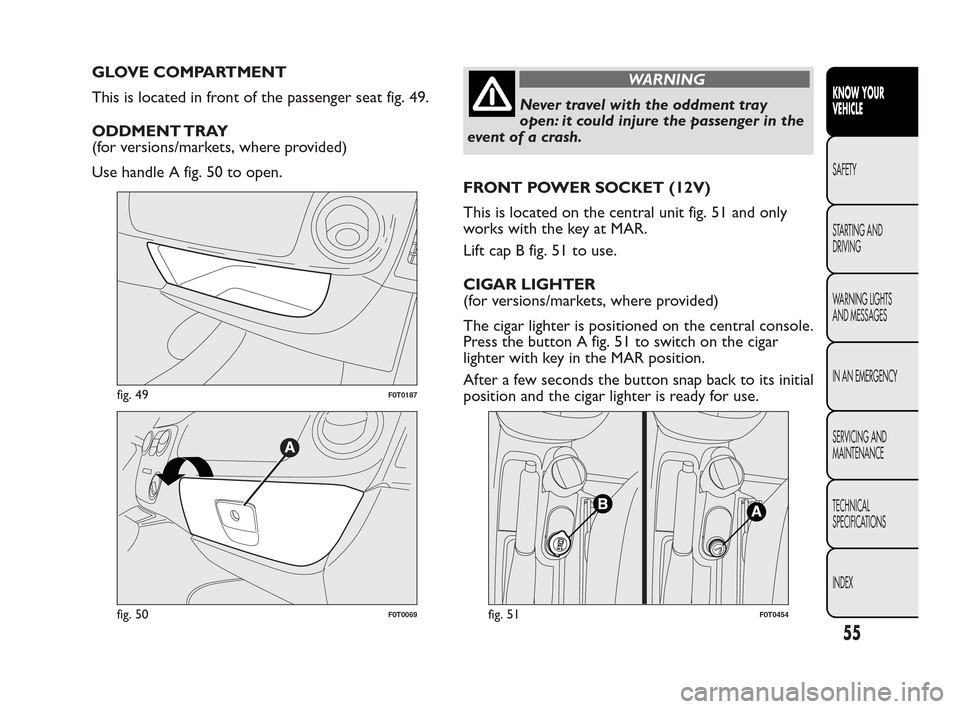
GLOVE COMPARTMENT
This is located in front of the passenger seat fig. 49.
ODDMENT TRAY
(for versions/markets, where provided)
Use handle A fig. 50 to open.WARNING
Never travel with the oddment tray
o
pen: it could injure the passenger in the
event of a crash.
FRONT POWER SOCKET (12V)
This is located on the central unit fig. 51 and only
works with the key at MAR.
Lift cap B fig. 51 to use.
CIGAR LIGHTER
(for versions/markets, where provided)
The cigar lighter is positioned on the central console.
Press the button A fig. 51 to switch on the cigar
lighter with key in the MAR position.
After a few seconds the button snap back to its initial
position and the cigar lighter is ready for use.
fig. 49F0T0187
fig. 50F0T0069fig. 51F0T0454
55
KNOW YOUR
VEHICLE
SAFETY
ST
ARTING AND
DRIVING
WARNING LIGHTS
AND MESSAGES
IN AN EMERGENCY
SERVICING AND
MAINTENANCE
TECHNICAL
SPECIFICATIONS
INDEX
Page 57 of 230
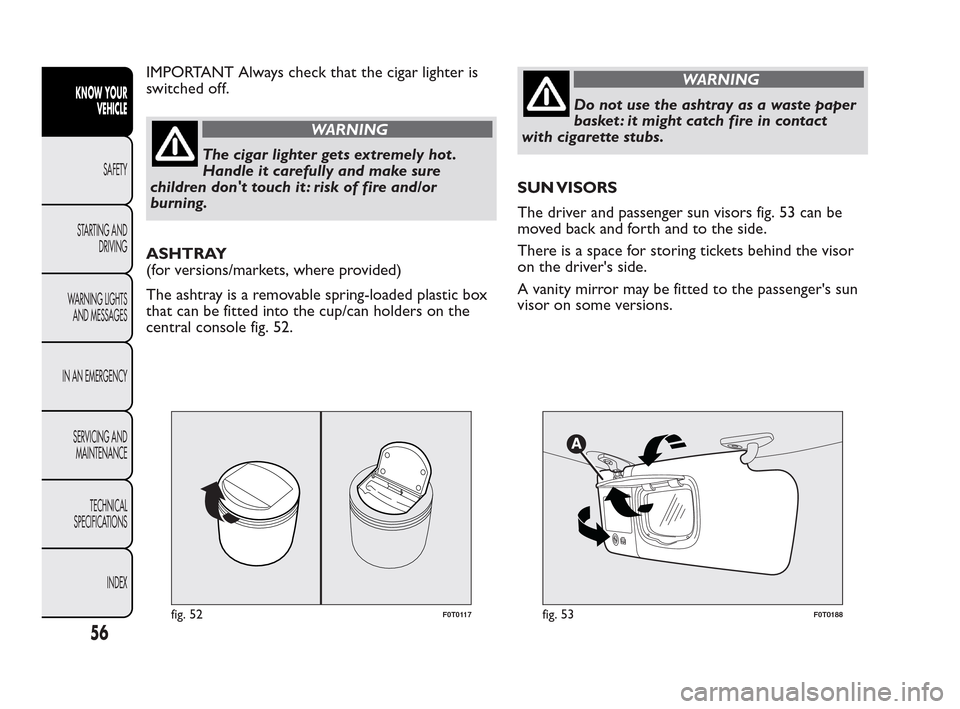
IMPORTANT Always check that the cigar lighter is
switched off.
WARNING
The cigar lighter gets extremely hot .
Han
dle it carefully and make sure
children don't touch it : risk of fire and/or
burning.
ASHTRAY
(for versions/markets, where provided)
The ashtray is a removable spring-loaded plastic box
that can be fitted into the cup/can holders on the
central console fig. 52.
WARNING
Do not use the ashtray as a waste paper
bask
et : it might catch fire in contact
with cigarette stubs.
SUN VISORS
The driver and passenger sun visors fig. 53 can be
moved back and forth and to the side.
There is a space for storing tickets behind the visor
on the driver's side.
A vanity mirror may be fitted to the passenger's sun
visor on some versions.
fig. 52F0T0117fig. 53F0T0188
56
KNOW YOUR
VEHICLE
SAFETY
ST
ARTING AND
DRIVING
WARNING LIGHTS
AND MESSAGES
IN AN EMERGENCY
SERVICING AND
MAINTENANCE
TECHNICAL
SPECIFICATIONS
INDEX
Page 58 of 230
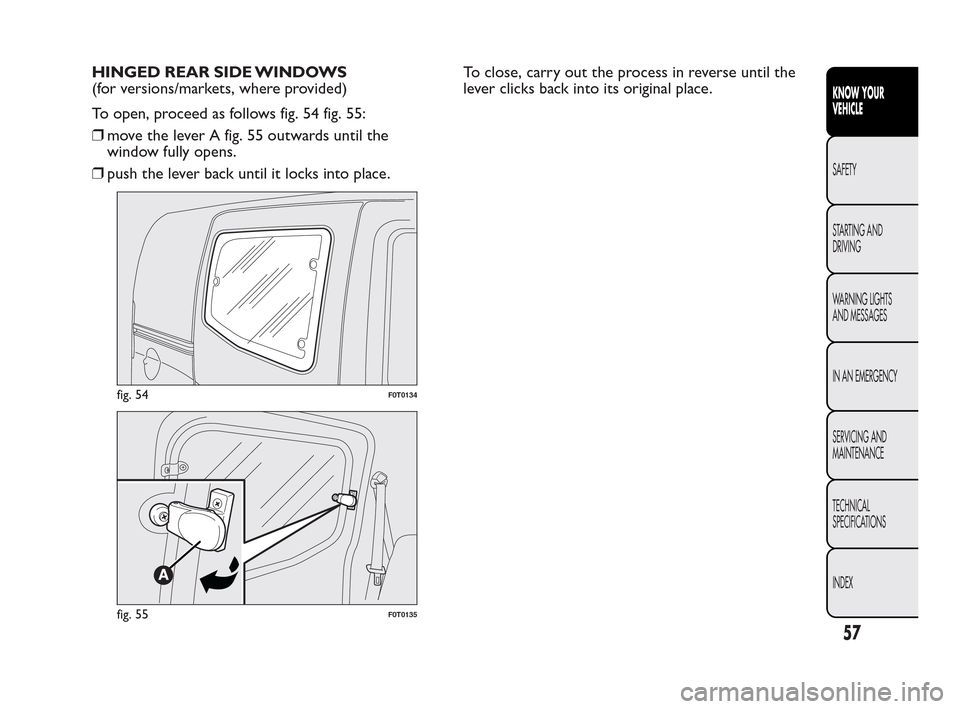
HINGED REAR SIDE WINDOWS
(for versions/markets, where provided)
To open, proceed as follows fig. 54 fig. 55:
❒move the lever A fig. 55 outwards until the
window fully opens.
❒push the lever back until it locks into place.To close, carry out the process in reverse until the
lever clicks back into its original place.
fig. 54F0T0134
fig. 55F0T0135
57
KNOW YOUR
VEHICLE
SAFETY
ST
ARTING AND
DRIVING
WARNING LIGHTS
AND MESSAGES
IN AN EMERGENCY
SERVICING AND
MAINTENANCE
TECHNICAL
SPECIFICATIONS
INDEX
Page 59 of 230
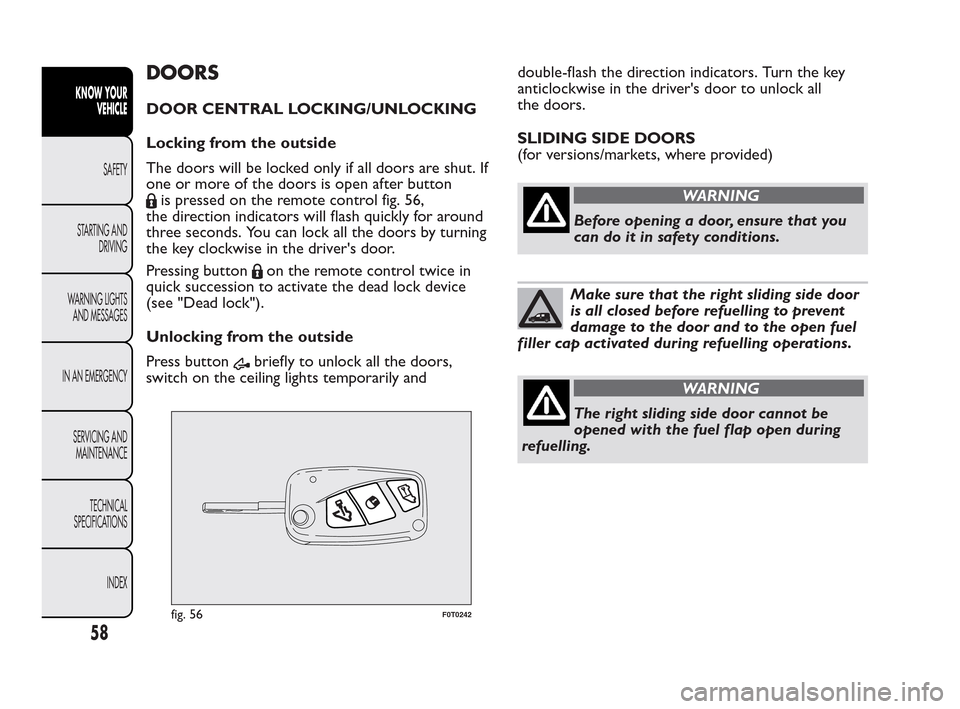
DOORS
DOOR CENTRAL LOCKING/UNLOCKING
Locking from the outside
The doors will be locked only if all doors are shut. If
one or more of the doors is open after button
is pressed on the remote control fig. 56,
the direction indicators will flash quickly for around
three seconds. You can lock all the doors by turning
the key clockwise in the driver's door.
Pressing button
on the remote control twice in
quick succession to activate the dead lock device
(see "Dead lock").
Unlocking from the outside
Press button
briefly to unlock all the doors,
switch on the ceiling lights temporarily anddouble-flash the direction indicators. Turn the key
anticlockwise in the driver's door to unlock all
the doors.
SLIDING SIDE DOORS
(for versions/markets, where provided)
WARNING
Before opening a door, ensure that you
can
do it in safety conditions.
Make sure that the right sliding side door
is all closed before refuelling to prevent
damage to the door and to the open fuel
filler cap activated during refuelling operations.
WARNING
The right sliding side door cannot be
o
pened with the fuel flap open during
refuelling.
fig. 56F0T0242
58
KNOW YOUR
VEHICLE
SAFETY
ST
ARTING AND
DRIVING
WARNING LIGHTS
AND MESSAGES
IN AN EMERGENCY
SERVICING AND
MAINTENANCE
TECHNICAL
SPECIFICATIONS
INDEX
Page 60 of 230
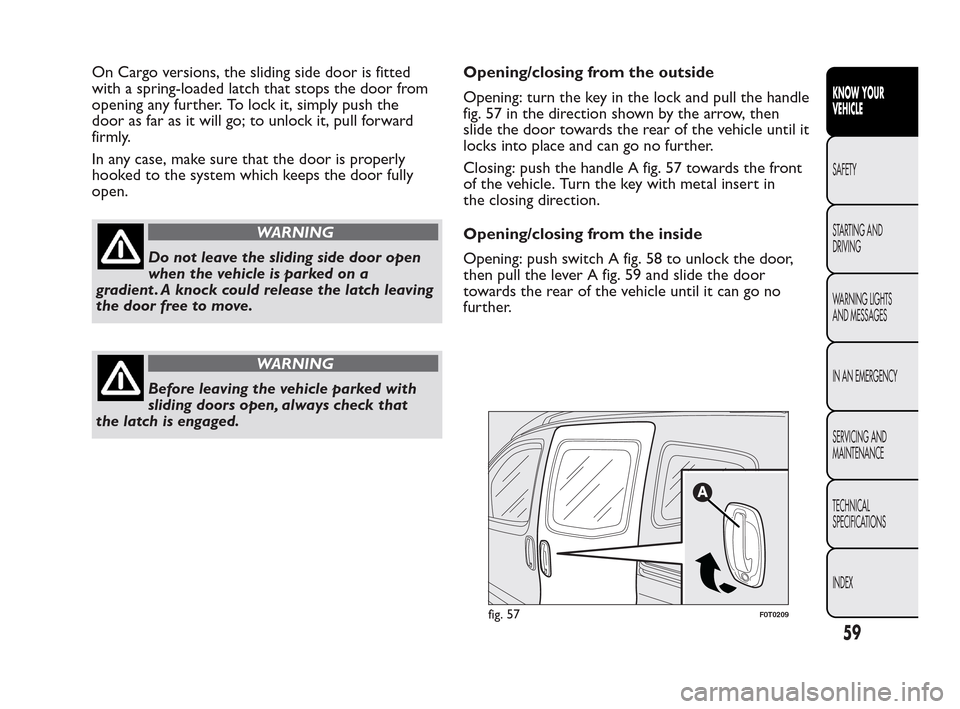
On Cargo versions, the sliding side door is fitted
with a spring-loaded latch that stops the door from
opening any further. To lock it, simply push the
door as far as it will go; to unlock it, pull forward
firmly.
In any case, make sure that the door is properly
hooked to the system which keeps the door fully
open.
WARNING
Do not leave the sliding side door open
w
hen the vehicle is parked on a
gradient . A knock could release the latch leaving
the door free to move.
WARNING
Before leaving the vehicle parked with
sli
ding doors open, always check that
the latch is engaged.Opening/closing from the outside
Opening: turn the key in the lock and pull the handle
fig. 57 in the direction shown by the arrow, then
slide the door towards the rear of the vehicle until it
locks into place and can go no further.
Closing: push the handle A fig. 57 towards the front
of the vehicle. Turn the key with metal insert in
the closing direction.
Opening/closing from the inside
Opening: push switch A fig. 58 to unlock the door,
then pull the lever A fig. 59 and slide the door
towards the rear of the vehicle until it can go no
further.
fig. 57F0T0209
59
KNOW YOUR
VEHICLE
SAFETY
ST
ARTING AND
DRIVING
WARNING LIGHTS
AND MESSAGES
IN AN EMERGENCY
SERVICING AND
MAINTENANCE
TECHNICAL
SPECIFICATIONS
INDEX
Page 61 of 230
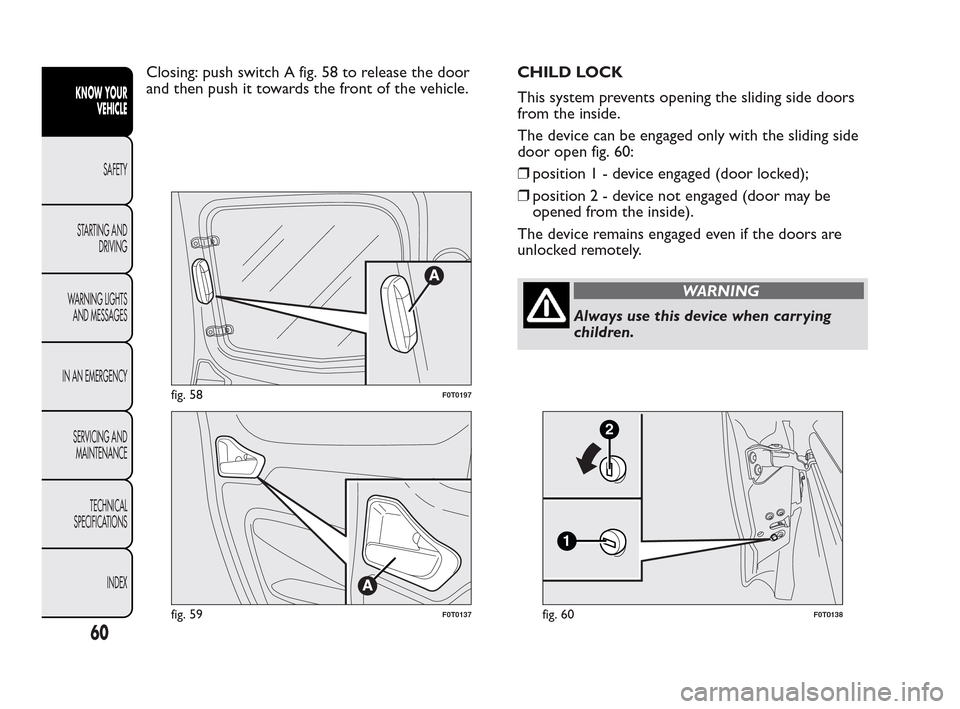
Closing: push switch A fig. 58 to release the door
and then push it towards the front of the vehicle.CHILD LOCK
This system prevents opening the sliding side doors
from the inside.
The device can be engaged only with the sliding side
door open fig. 60:
❒position1-device engaged (door locked);
❒position2-device not engaged (door may be
opened from the inside).
The device remains engaged even if the doors are
unlocked remotely.
WARNING
Always use this device when carrying
children.
fig. 58F0T0197
fig. 59F0T0137
1
2
fig. 60F0T0138
60
KNOW YOUR
VEHICLE
SAFETY
ST
ARTING AND
DRIVING
WARNING LIGHTS
AND MESSAGES
IN AN EMERGENCY
SERVICING AND
MAINTENANCE
TECHNICAL
SPECIFICATIONS
INDEX
Page 62 of 230

WINDOWS
FRONT ELECTRIC WINDOWS
(for versions/markets, where provided)
Buttons fig. 61 are located on the driver's door panel
to control the following functions with the key on:
A: Opening/closing left window
B: Opening/closing right window
Push button A or B to open/close the appropriate
window.
When one of the two buttons is pressed briefly, the
window moves in stages; if the button is held down,
"continuous automatic" operation is activated both
for closing and opening. Press button A or B again to
stop the window in its current position.
The electric windows are fitted with a security
system (for versions/markets, where provided) that
can detect the presence of an obstacle whilst thewindow is closing; when this happens, the system
kicks in and the movement of the glass is
immediately reversed.
IMPORTANT The system will automatically enter
“recovery” mode (self-protection) if the anti-crushing
function is activated 5 times in only one minute.
This condition is apparent because the window
closing in stages.
If this occurs, restore the system as follows:
❒open the windows;
or
❒turn the key off (STOP position) and then on
(MAR).
If no malfunction is present, the window returns to
its normal operation automatically.
IMPORTANT With the key off or removed, the
windows remain activated for about two minutes and
are deactivated as soon a door is opened.
fig. 61F0T0044
61
KNOW YOUR
VEHICLE
SAFETY
ST
ARTING AND
DRIVING
WARNING LIGHTS
AND MESSAGES
IN AN EMERGENCY
SERVICING AND
MAINTENANCE
TECHNICAL
SPECIFICATIONS
INDEX
Page 63 of 230
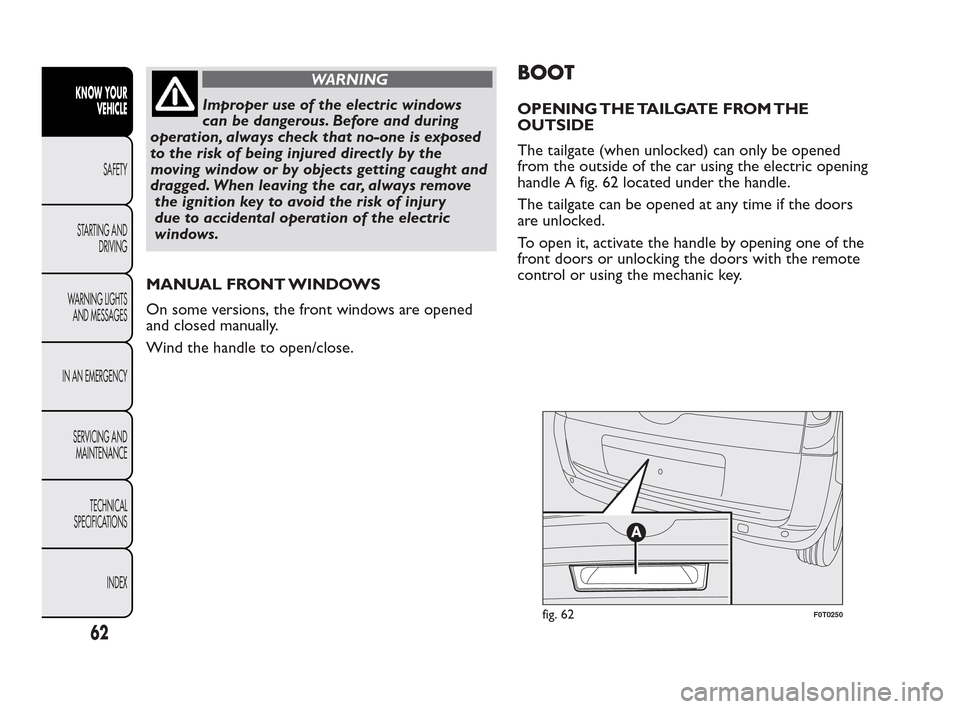
WARNING
Improper use of the electric windows
can
be dangerous. Before and during
operation, always check that no-one is exposed
to the risk of being injured directly by the
moving window or by objects getting caught and
dragged. When leaving the car, always remove
the ignition key to avoid the risk of injury
due to accidental operation of the electric
windows.
MANUAL FRONT WINDOWS
On some versions, the front windows are opened
and closed manually.
Wind the handle to open/close.
BOOT
OPENING THE TAILGATE FROM THE
OUTSIDE
The tailgate (when unlocked) can only be opened
from the outside of the car using the electric opening
handle A fig. 62 located under the handle.
The tailgate can be opened at any time if the doors
are unlocked.
To open it, activate the handle by opening one of the
front doors or unlocking the doors with the remote
control or using the mechanic key.
fig. 62F0T0250
62
KNOW YOUR
VEHICLE
SAFETY
ST
ARTING AND
DRIVING
WARNING LIGHTS
AND MESSAGES
IN AN EMERGENCY
SERVICING AND
MAINTENANCE
TECHNICAL
SPECIFICATIONS
INDEX